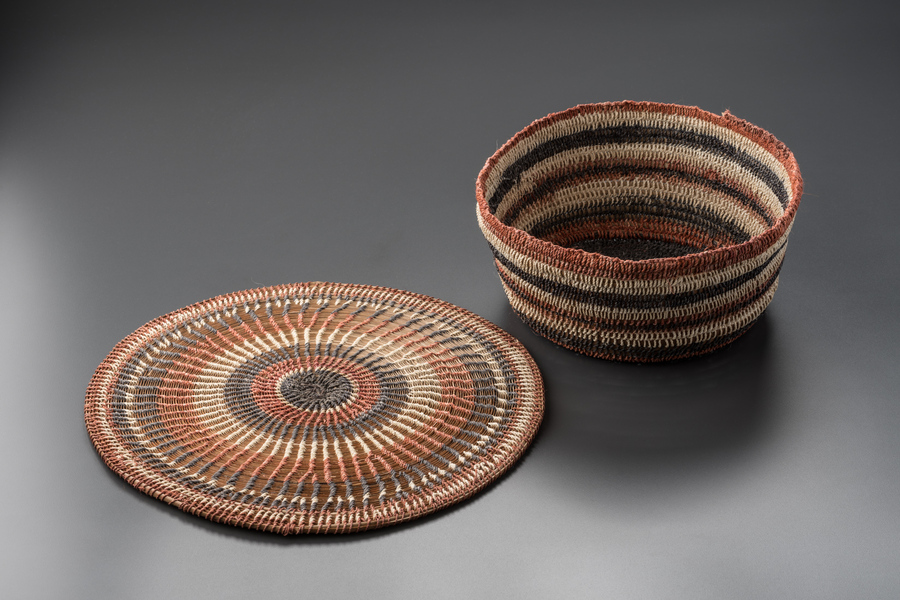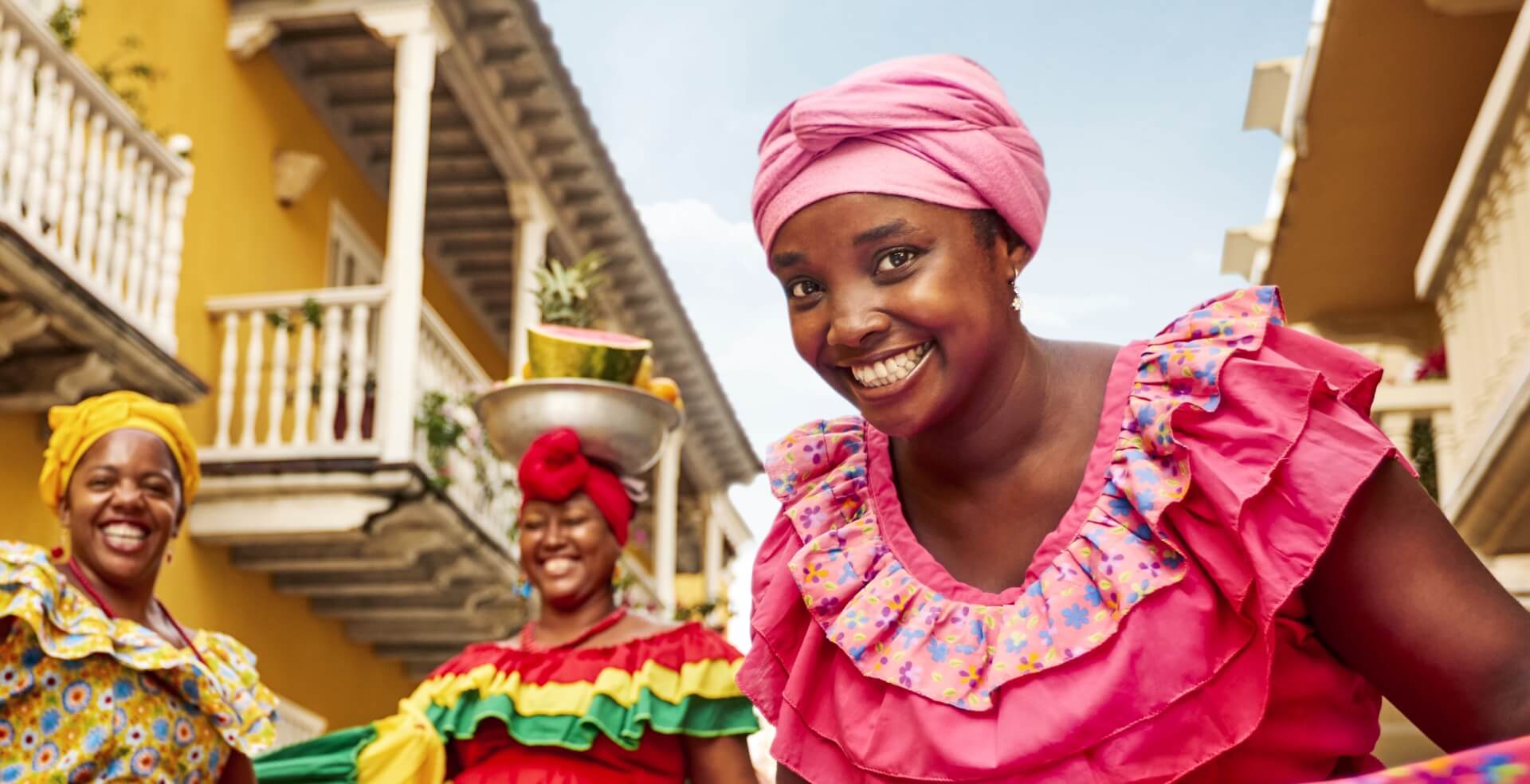The development of products around artisanal practices, such as Colombian handicrafts, allows the country to grow culturally and enables artisans to engage in the cultural tourism chain. For this reason, it is important to promote greater efficiency between supply and demand for handicrafts. Furthermore, maximizing tourism benefits is essential for both business productivity and receiving communities.
Discover the other 4 artisan routes created by Artesanías de Colombia, and enjoy everything they have to offer. Visit Colombia and be part of cultural tourism through this journey.
Read the first part of the Colombian Handicrafts route: Caribbean and Andean Region
Colombian Handicrafts: Amazon Artisan Route
Highlighted crafts: weaving, basketry, wood carving, pottery.
Iconic crafts: benches, canes, masks, backpacks, hammocks, belts, baskets, fans, jewelry, plates, and glasses.

Container and individual items belonging to the Amazon Artisan Route of Artesanías de Colombia.
The Amazon Region is the perfect place for cultural, ecological, and adventure tourism. Its landscapes are enchanting, and you can also interact with the indigenous communities living there.
This artisan route allows you to learn about the traditions of different ethnic groups and interact with the communities of the Amazon. Additionally, you can observe master artisans at work while they narrate stories that have been passed down through generations.
Colombian handicrafts tell the story of indigenous peoples and their relationship with nature. These crafts, made by artisans with transformed and collected materials from the jungle, can be purchased directly in communities and workshops located in Leticia.
Discover modern sounds inspired by the Colombian Amazon
How to get to the Amazon?
You should take a flight to Leticia from El Dorado International Airport in Bogotá. The journey takes approximately 2 hours. There, you can visit nearby communities by land or river routes.
Events and festivals you can't miss
- Gastronomic and Craft Fair: during the month of April.
- International Fraternity of the Amazon: in August.
- International Festival of Tourism and Amazonian Culture: held in September.
- Artisan Fair: in October.
- International Pirarucú de Oro Festival: during November.
Traditional dishes you must try
The gastronomy of the Amazon is influenced by the river. Standouts include Pirarucú fish, yuca, plantains, ants, and robust flavors. Additionally, chili peppers and juices from typical regional fruits like copoazú and arazá are also very traditional.
Colombian Handicrafts: Aguadeño Hat Route
Highlighted crafts: weaving in iraca palm.
Iconic crafts: aguadeño hat.

Hat belonging to the Aguadeño Hat Route of Artesanías de Colombia.
The municipality of Aguadas boasts rich artistic, cultural, artisanal, historical, and architectural heritage. Additionally, it is part of coffee culture and is one of the most beautiful places in Caldas.
This artisanal tourism route begins with visits to places where iraca palm fiber is prepared for weaving. Shortly afterward, you can visit the home of Martha Luz Giraldo, a weaver of the aguadeño hat. You can also visit Palmato, a company that produces and markets hats woven by hand by rural women in the region.
During this journey, you must not miss visiting El Taller del Sombrero and the Hat Museum, places created by master artisans with years of experience. Additionally, you can witness the teaching of these Colombian handicrafts to new generations and learn about more than 300 types of hats exhibited at the National Hat Museum.
How to get to Aguadas?
You should take a flight to Manizales or Medellín from El Dorado International Airport in Bogotá. From either of these cities, you can take a bus to Aguadas, with a journey time of approximately 3.5 hours.
Events and festivals you can't miss
- National Colombian Pasillo Festival: held in August and considered one of the most important nationwide.
- Iraca Festivities: this event is celebrated in June and is the perfect place to celebrate the work of artisans and weavers.
Traditional dishes you must try
The most famous dish in the region is the aguadeño pionono. It consists of a soft flour dough made artisanally and filled with arequipe, brevas, and bocadillo. This dish, crafted by Aguadas families, has won various gastronomic competitions.
Colombian Handicrafts: Guane Path Route
Highlighted crafts: fique weaving, stone carving, basketry, and ceramics.
Iconic crafts: Guane weaving, fique textiles, sacks, woven rugs, backpacks, sculptures, religious images, and decorative spheres.

Rug belonging to the Guane Path Route of Artesanías de Colombia.
This cultural tourism destination is one of the most artisanal in the area, as men and women create crafts that reflect their identity and regional customs. Here, the traditions of indigenous groups are preserved along with the materials they used in past years.
The Guane Path route begins in Curití, which in Guane means "town of weavers" and where woven textiles have become a must-see for visitors. A short distance away is San Gil, also renowned for its fique crafts, extreme sports, and beautiful landscapes.
Afterward, you can visit Barichara, a Colombian Heritage Town where handicrafts are visible in every corner. Its streets and houses showcase the hard work in stone that has been carried out for years by the people of Santander.
Transport yourself back in time walking through the beautiful streets of Barichara
How to get to Guane?
You can take a flight to Bucaramanga from El Dorado International Airport in Bogotá. From there, take a bus to Barichara with a journey time of approximately 3 hours. Once you reach the area, you can use public transport or walk to the following destinations.
Events and festivals you can't miss
- Local Festival of San Lorenzo Mártir: held in August and is the perfect place to explore Guane customs.
- Festival of the Middle Magdalena: held in September.
- Regional Culinary Festival: in December.
- Christmas fair: celebrated during the entire month of December.
Traditional dishes you must try
The gastronomy of the Guane Path is influenced by the Andean region. Some of the favorite dishes include carantanta, sancocho, roasted goat, mute, and grated cassava. Additionally, you can also find dishes that are characteristic of the Santander department in this destination.
Colombian Handicrafts: Tolimense Route
Highlighted crafts: goldsmithing, pottery, blacksmithing, basketry, leather goods, and embroidery.
Iconic crafts: musical instruments, leather hats, hammocks, totonas, bags, statues, and masks.

Container and individual items belonging to the Tolimense Route of Artesanías de Colombia.
The Tolimense Route is characterized by the richness of its folklore and handicrafts, as it includes leatherwork and goldsmithing. Moreover, in the department of Tolima, which has been influenced by the indigenous Pijao people, you can discover the culture and artistic heritage of their indigenous cultures. These artistic crafts are valuable due to the beauty of their designs.
During your visit to the department of Tolima, be sure to go to one of the routes promoted by the Ibalucán Handicrafts, which present the Pijao culture and have been carried out for generations. A route to find Pijao handicrafts. Visiting communities, understanding between also play on crafted this Colombia route.















